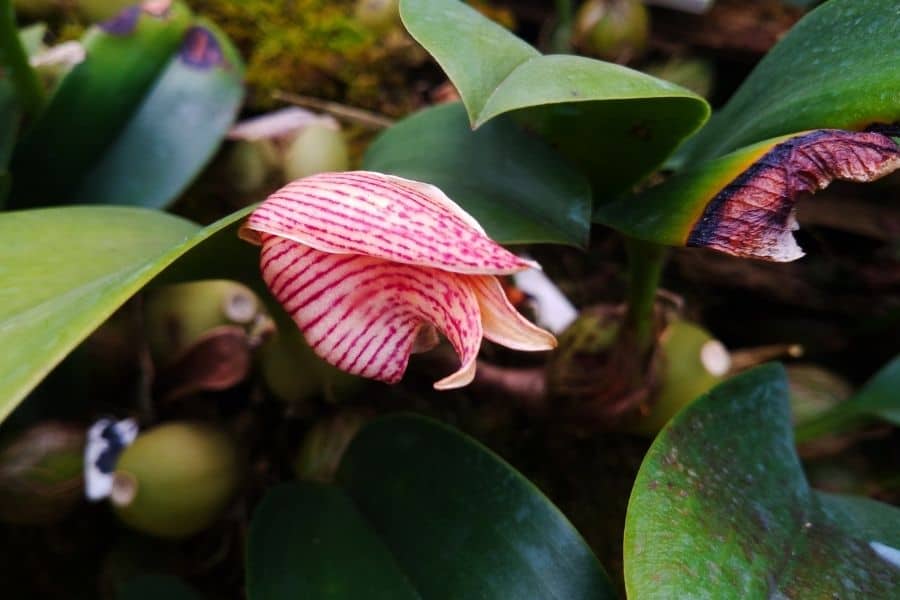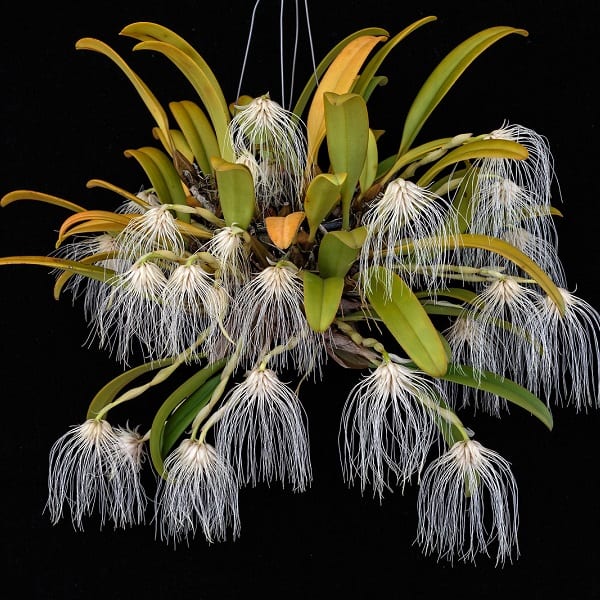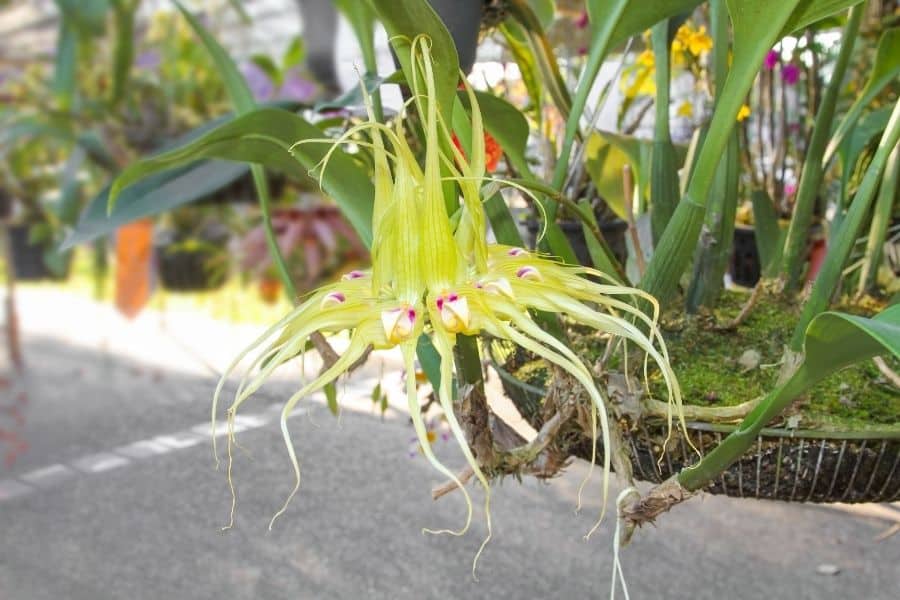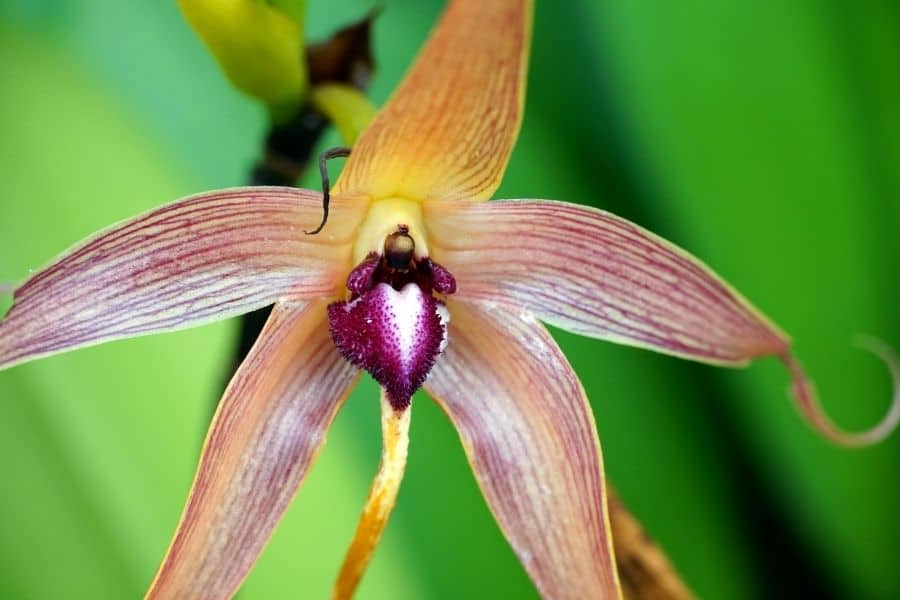30 Bulbophyllum Orchids: Identification and Care Essentials
Orchids are some of the most beautiful and fascinating flowers in the world. One exciting group is the Bulbophyllum orchids. These plants come in many different shapes, sizes, and colors, and they’re pretty cool to grow!

Contents
- 1 What Are Bulbophyllum Orchids?
- 2 How to Say Bulbophyllum
- 3 Where Do Bulbophyllum Orchids Come From?
- 4 Types of Bulbophyllum Orchids
- 5 Growing Bulbophyllum Orchids
- 6 Caring for Your Bulbophyllum
- 7 Repotting Bulbophyllum Orchids
- 8 Propagating Bulbophyllum Orchids
- 9 Pollinating Bulbophyllum Orchids
- 10 Getting Blooms on Bulbophyllum
What Are Bulbophyllum Orchids?
Bulbophyllum orchids are a huge group of orchids with over 2,000 different species! They were first discovered way back in 1822 by a French botanist named Louis-Marie Aubert du Petit-Thouars.
These orchids have a unique feature – they have little bulb-like structures called pseudobulbs along their stems. Each pseudobulb usually grows a single leaf. That’s where the name “Bulbophyllum” comes from – it’s a combination of the Greek words for “bulb” and “leaf.”
How to Say Bulbophyllum
The name Bulbophyllum might look tricky to pronounce, but it’s not too bad once you break it down. Say it like this: bulb-oh-fill-um. Just remember it’s all about those bulbs and leaves!
Where Do Bulbophyllum Orchids Come From?
These orchids are found mostly in tropical areas around the world. The biggest variety is in New Guinea, where over 600 different Bulbophyllum species grow. Scientists think this may be where the plants originally came from.
You can also find Bulbophyllum orchids in many parts of Asia, Africa, Central and South America, and the Caribbean islands.
Types of Bulbophyllum Orchids






























Growing Bulbophyllum Orchids
Bulbophyllum orchids can be pretty easy to grow if you give them the right conditions. Some species grow on soil, while others grow on trees or other plants. This means you can pot some types in a special orchid mix or mount them on bark or cork.
No matter how you grow them, these orchids need lots of moisture and high humidity, just like in their tropical homes. A potting mix with ingredients like sphagnum moss, perlite, coconut fiber, and charcoal works well to keep the roots moist.
Caring for Your Bulbophyllum

Taking care of your Bulbophyllum orchid will depend a bit on which specific type you have and where it’s from originally. But in general, here are some tips:
- Light: Most Bulbophyllums like medium to bright, indirect light. Too much direct sun can damage the leaves.
- Temperature: These orchids prefer warm temperatures, usually between 70-80°F (21-27°C). At night, they like it a bit cooler, around 60-65°F (16-18°C).
- Water: High moisture is key! Water potted plants every 3-4 days, and mounted plants daily or twice a day. Never let the mix dry out completely.
- Humidity: Misting the leaves or using a humidity tray will help provide the high humidity Bulbophyllums crave.
- Fertilizer: Use a balanced fertilizer every 2 weeks during the growing season.

Repotting Bulbophyllum Orchids
The roots on Bulbophyllum orchids are very delicate, so you don’t want to repot them too often. It’s best to only repot every 2-3 years when you see new growth starting, usually between August and January. Be very gentle when removing the plant from its old pot so you don’t damage the roots.
Propagating Bulbophyllum Orchids
It can be tricky to propagate these orchids at home since they need warm, humid conditions. But you can try stem cuttings! Cut a stem section at least 4 inches long with a few nodes (bumpy areas). Remove a few of the bottom leaves and set the cuttings on a tray of damp sphagnum moss. Cover with a plastic bag to keep humidity in until new growths appear in a few months.
Pollinating Bulbophyllum Orchids
In nature, flies help pollinate these orchids. To hand-pollinate, use a toothpick or cotton swab to carefully open up the flower center. Look for the yellow anther cap – this covers the pollen. Remove the cap and use the swab to collect some sticky pollen. Then dab the pollen onto the sticky surface of the female part to pollinate.

Getting Blooms on Bulbophyllum
The keys to getting Bulbophyllum orchids to bloom are giving them:
- The right light – bright, indirect light tends to encourage flowering
- Proper temperatures with a cooler night period
- Consistent moisture and high humidity
- For some types, a drier “resting” period triggers blooms
With patience and the right care, you’ll be rewarded with exotic, long-lasting flowers!
